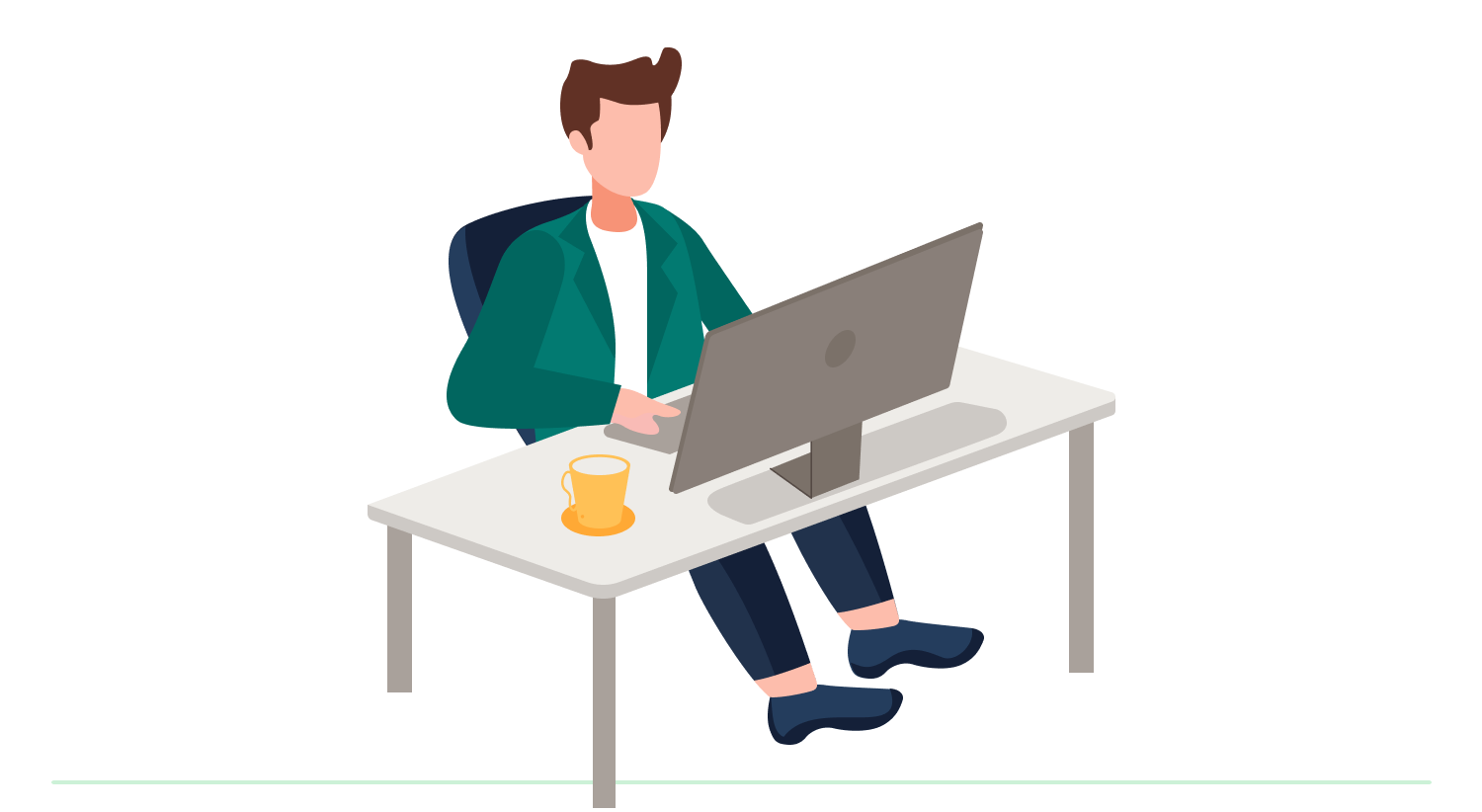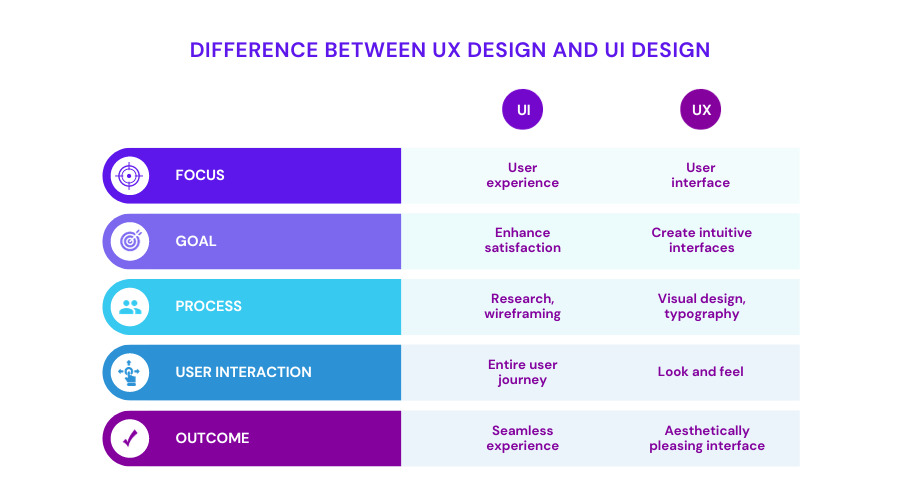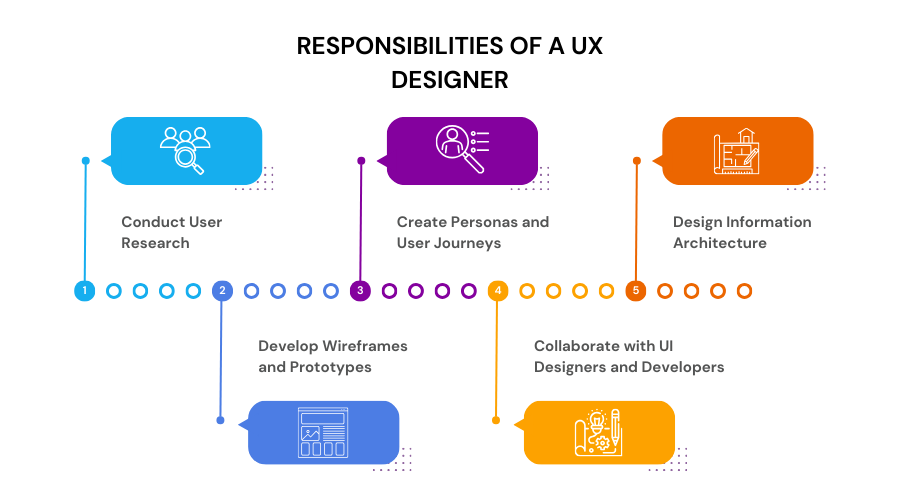
What Is UX Design?
Have you ever used an app or website that felt unintuitive and frustrating to navigate? Or come across a product that didn’t seem designed with customers in mind? That’s where user experience design comes in.
Want your users to fall in love with your designs? Fall in love with your users
Dana Chisnell
UX design is creating products that provide personalized, seamless experiences for users. The goal is to make people’s interactions with technology feel natural and satisfying. UX designers are concerned with how users perceive and respond to a design emotionally and rationally.
A big part of the job involves empathy. That is, walking in users’ shoes to understand their needs, pain points, and behaviors. Designers conduct user research through surveys, interviews, and usability testing to gather insights. They analyze how people currently complete tasks and identify opportunities to improve.
Now a lot of times people often get confused between UX and UI design, lets get that cleared before we move forward.
Shall we?

With these insights, UX designers create conceptual models of how a product could get structured for maximum ease of use. They map out user flows and prototype interface designs. Their work spans digital and physical products, from mobile apps and websites to home appliances and smart devices.
A well-designed UX helps users complete their intended tasks as efficiently as possible with minimal frustration. It supports users’ cognitive processes and makes systems feel intuitive to understand. At its best, UX design creates products people enjoy using so much that they feel eager to use them again and again.
Now, Who Is a UX Designer?
UX Designer Definition:
A UX designer focuses on creating intuitive and satisfying experiences for people using technology. Their job is to understand how real people will interact with a product and make sure the design meets their needs in an easy and enjoyable way.
Did you know that after a negative user experience, 88% of users are less inclined to return? That’s how essential a good user experience is.
A UX Designer is responsible for ensuring that the products work smoothly, the user experience is always at the forefront of the design, and customer satisfaction is not just aimed for but achieved during the whole development process.
A typical day for a UX designer involves a lot of creativity and problem-solving. They constantly study user behavior to understand what works well and what could be improved. They develop new ideas for designing apps, websites, or other digital products that genuinely cater to people’s needs.
Suggested Read: What Is UX Product Manager? Definition, Role and Salary
What Does a UX Designer Do?

Part detective, part advocate, you as a UX designer will delve into understanding user needs and implement intelligent design choices to meet them. Each project involves a comprehensive understanding of both users and business goals.
Research plays a crucial role. You conduct interviews, surveys, and usability tests to uncover pain points and desires. Personas and user flows emerge from these insights, allowing you to map the journey for smooth task completion.
With a user-centered mindset, you sketch wireframes, prototypes, and site maps. Visualizing designs facilitates evaluation, and revisions lead to an intuitive interface, often crafted by a UX designer.
Collaboration is paramount. You present ideas and gather feedback from stakeholders. Changes arise from user testing, where observing real people interact provides validation.
Solving problems through iterative design, you craft the optimal experience. Presenting solutions demonstrates how business objectives align with helping users. The work is never truly complete as needs evolve. However, through understanding and advocacy, you empower users, always designing with their best experience in mind.
Suggested Read: What Is User Interface (UI)? Definition and Examples
Where Do UX Designers Work?
Here are some of the top industries that employ UX designers:
- Computing/Software: As the birthplace of UX design, many designers cut their teeth while developing user-friendly websites, apps, and software. Tech companies are always looking for ways to improve the user experience, so this is the most obvious space to work.
- Finance: With many banking and payment apps, the financial industry relies on designers to simplify and secure complex tasks. Usability is crucial when dealing with people’s money.
- Consulting: Some designers work as consultants, advising companies across industries on how design can solve problems and improve business metrics.
- Education: As online education grows, designers create intuitive learning platforms and apps for studying.
- Government: Websites that efficiently deliver services and emergency alerts need designer input
- Healthcare: From scheduling to telemedicine, healthcare leverages design to benefit patients and providers.
- Retail: Design drives the e-commerce experience on sites and shopping apps centered on customer convenience.
- Media/Publishing: Designers craft experiences for e-readers, publishing platforms, and content distribution.
- Advertising: By understanding trends and storytelling, designers engage audiences amid skepticism around ads.
- Telecom: Smartphone interface design had a huge impact, though surprisingly, few designers reported working directly in this industry.
- Entertainment: Design keeps customers engaged on streaming platforms through personalization, ease of use, and accessibility.
- Emerging Tech: New areas like smart homes, AI, and more will generate many design jobs shaping interactive innovation.
So, in summary, while tech remains a natural home, UX designers apply their skills across many sectors to improve all kinds of digital products and services. Usability applies everywhere.
Suggested Read: CX vs UX: What’s the Difference
Skills Needed to Become a UX Designer
Here are the essential skills a UX designer needs to succeed:
- Prototyping and Wireframing: Creating wireframes, mockups, and prototypes is crucial for bringing designs to life. Practice sketching user flows and trial designing apps you use daily to build these skills.
- Visual Design: UX designers use tools like Figma, Sketch, and Photoshop to craft visually appealing interfaces. Developing proficiency and knowledge of the best typography, color, layout, and more practices will serve you well.
- User Research: Understanding users through research is paramount. Conducting user interviews and testing prototypes will empower you to improve designs continually. Some teams even specialize in UX Research.
- Agile Methodology: Many software teams utilize Agile project management. Learning the core tenets of Agile, like its iterative process, can strengthen your collaboration and deliverables.
- Information Architecture: Organizing content effectively helps users navigate smoothly. Practice hand-drawing sites’ information structures to analyze what makes for good IA.
- Development Fundamentals: While not coding, understanding languages like HTML, CSS, and JavaScript fosters realistic expectations and collaboration with developers.
- Collaboration: As part of interdisciplinary teams, nurture feedback-sharing and incorporate ideas to craft the ultimate product experience.
- Communication: Effective communication is crucial throughout all project stages, whether presenting research or designs and gaining user insights. Strong communication skills are paramount in informing and facilitating these key aspects.
- Time Management: Juggling multiple projects demands organizational finesse. Develop flexibility and prioritization to address critical needs efficiently.
This versatile skillset blends technical expertise with strong, soft skills. Approach each new project as an opportunity to grow and continually learn. Know that a fluid, engaging approach will take your UX career places.
How to Become a UX Designer?
Although many UX designers begin their web design or development journey, individuals in related fields can also acquire the necessary skills to transition into UX design.
Let us explore the steps to becoming a UX designer without prior experience, delve into the time it takes to achieve proficiency and outline the qualifications needed for employment.
Enroll in a UX Design Course
As technology continues to evolve at lightning speed, the demand for User Experience (UX) designers is higher than ever. With your help, companies can build products, websites, and apps that are intuitive, enjoyable to use, and meet people’s real needs. A UX course is a smart choice if you want to break into this in-demand field.
While a bachelor’s or master’s degree in Human-Computer Interaction or Interaction Design can provide a solid foundation, not everyone has the time or money for a traditional multi-year program. Luckily, there are now many high-quality online UX design courses that allow you to gain the skills and qualifications in a more flexible, accelerated format.
For example, Google’s UX Design Professional Certificate is one of the top options. For six months, you’ll learn UX design principles, techniques for conducting user research, best practices for prototyping and testing, and more. Along the way, Google’s instructors provide feedback to help improve your work. Upon completing the projects and exams, you earn a certificate that over 150 major companies recognize, including Google.
Other excellent choices include Coursera’s Introduction to User Experience Design from the by the Georgia Institute of Technology or Interaction Design Foundation’s User Experience: The Beginners Guide course.
No matter which course you select, hands-on projects allow you to build a portfolio demonstrating your growing abilities to potential employers.
Develop Independent Design Projects
Completing UX design projects during your formal studies is an excellent starting point. Still, to truly excel at the craft, you need real-world experience.
Don’t limit your learning to assignments. Take the initiative to design independently. Continually pushing your abilities outside the classroom is critical to becoming a top-notch designer.
While coursework gives you structure and deadlines, independent work cultivates creativity. You can experiment fearlessly when you design projects solely for your interest and growth. You can explore untapped ideas without restrictions, expanding your toolset and developing unique solutions. Stretch your wings and take bold conceptual risks you may not get to in class.
After finishing a self-directed design, showcase your work on platforms in the community. Sites like Behance and Dribbble offer a global stage for UX professionals to connect, learn, and evaluate each other’s portfolios.
Posting your independent designs is a win-win – you get valued feedback from experts while growing recognition for your skills. Don’t be shy about showcasing your passion. Outstanding work will surely attract opportunities and partnership offers.
Get Hands-On Experience That Will Take Your Career to the Next Level
While studying UX principles in the classroom is essential, there’s no substitute for real-world experience.
Design internships are an excellent way to learn while contributing. In addition to honing technical skills like wireframing and prototyping, you’ll develop crucial soft skills. Learning firsthand is the best way to grasp project management, collaboration, and client communication skills. Internships also provide valuable networking contacts that could lead to future opportunities.
Freelancing is another effective path for expanding your portfolio and client list. Sites like Upwork offer hundreds of remote UX design contracts posted by agencies and companies worldwide. You can take on projects at your own pace while gaining exposure to different industries and challenges.
Craft a Standout Portfolio
More than just a collection of pretty visuals, your portfolio must strategically showcase your process, problem-solving abilities, and impact.
Be selective. Only include your strongest 5-7 pieces that demonstrate diverse skills. Optimize each project page to trace your design thinking journey, from research and insights to iterative prototypes. Bring designs to life with high-fidelity clickable demos whenever possible.
Mix in clients’ projects, schoolwork, and personal initiatives. Add anything displaying an user-centered approach. Feature a blend of branding, visual, and UX design to show versatile aptitude. Quantify results through analytics and testimonials to emphasize tangible benefits delivered.
Presentation matters. Curate an aesthetic, intuitive website using a platform like Wix or Webflow. Optimize for mobile and add professional touches like your tailored resume. Promote widely on LinkedIn and specialized sites.
Network Within the Field
Networking with personal and professional connections fills 85% of job positions!
As a UX designer starting in the industry, one of the smartest moves you can make is to focus on building your professional network. Developing your skills through education and practice is essential, and cultivating meaningful connections can significantly accelerate your career.
Seasoned designers, potential mentors, and future employers are all just a handshake away when you put effort into networking effectively.
Networking opens doors to invaluable wisdom and guidance from those who have walked the path before you.
By reaching out to experienced UX professionals, you gain insight into best practices, tools of the trade, and emerging trends straight from the source. Beyond textbook learning, real-world perspectives on challenges, solutions, and opportunities help shape your approach. With care and follow-through, initial conversations can sprout long-term mentorships that steer your development.
Of course, the benefits of networking go beyond education. As your network expands, so do opportunities for advancement. Designers with established careers often hear roles becoming available at their companies before postings go live.
A friendly introduction from someone already in your targeted company or industry can work wonders for landing an interview. And who better to vouch for your potential than respected contacts who have seen your dedication and skills firsthand? The right referral skips straight to the top of an overflowing applicant pile.
An excellent place to start cultivating connections is joining professional organizations and online communities centered around UX design.
Places like Design Buddies on Discord or LinkedIn groups bring together like-minded peers at various stages of their careers. Tap into conversations, ask questions respectfully, and seek out those whose backgrounds particularly interest you. Be generous with your time and knowledge to build rapport and goodwill within the network.
Apply for UX Designer Positions
You’ve laid the groundwork by honing your UX designer skills, building a robust network, and constructing a stellar portfolio. Now, as you stand at the gateway to your professional future, the next important step is strategically applying for UX designer jobs.
Don’t just randomly apply to any listing you see. Take the time to craft a job search strategy thoughtfully. Consider the type of company culture, work you find most fulfilling, location priorities, and career growth opportunities that are important to you. Research companies that align with your preferences.
Make sure you have optimized your resume and online portfolio for each application. Highlight relevant experiences and accomplishments. As mentioned earlier, feature your most vital work demonstrating must-have qualifications. Tailor the content to the specific job requirements.
Reach out to your contacts. Inform them of your job search and ask if they know of any opportunities. Many roles are never publicly listed. Your network can connect you with hiring managers directly. Send thank you notes to stay top of mind for referrals.
Read UX designer job description carefully and show how you specifically meet their needs. Reference aspects of the role and company that appeal to you. Customize your cover letter for each application rather than using templates. Make a genuine personal connection.
Apply directly on company career pages, too. Follow companies on LinkedIn and look for new posts. Attend industry events and meetups to discover chances naturally. Persistence and creativity will help uncover hidden gems.
Working as a UX designer means continuously learning, adapting, and improving your UX designer skills to understand users better and solve problems through intuitive design. While it requires dedication to hone your broad range of abilities, having a curious mind and passion for understanding human behavior will serve as your strongest assets.
If you find satisfaction in seeing your ideas come to life and helping others through design, then a career crafting meaningful interfaces may be calling your name.
The journey ahead is what you make of it. So why not start exploring your potential to become the next designer who makes an impact? The future is open, so go ahead and start shaping it.
FAQs
Yes, UX design offers a promising career path with high demand across industries. It combines creativity, problem-solving, and technology, providing ample growth opportunities and diverse career paths.
As of February 2023, the average base UX designer salary in the United States stands at $94,577 per year, according to Glassdoor. This information positions UX design favorably, as it ranks as the sixth highest-paying entry-level job in Glassdoor’s list of 25 positions.
Qualifications can vary, but a bachelor’s degree in graphic design, interaction design, or a related discipline is beneficial. UX design, software, prototyping, user research, and collaboration skills are essential.
The duration varies. A bachelor’s degree typically takes around 3-4 years to complete. To specialize in UX design, additional learning through courses or boot camps can take anywhere from a few months to a year, depending on the program’s intensity and prior knowledge.
